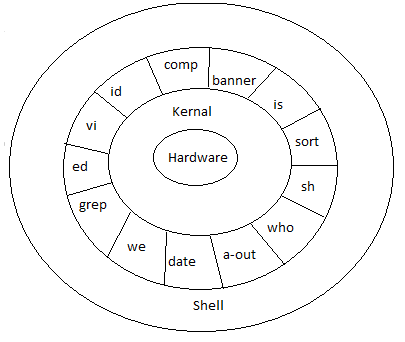

Kernel
Actions :
The Shell
Features of shell are :
Process Management
CPU Scheduling
Memory Management
File Management
Types of UNIX users
- root - non-root
- Unix allows user ID’s to be grouped - A single user ID can be member of multiple groups
-OWNER -Group -others Working with UNIX
exec() Excel, Excel p, Excel e, Excel v, Excel vp – executes a file Synopsis # include <Unistd. h> Extern char ** en viron; Int excel (const char * path , const char * arg,……………); Int excel p (const char * file , const char * arg,……………); Int excel e (const char * path , const char * avg,…, char * const envp [] ) ; Return Value If any of the exec () functions returns , an error will have occurred. The return value is -1, and the global variable err no will be set to indicate the error. Files /bin/sh System () System - executes a shell command Synopsis # include <stdlib.h> Int system (const char * command;) Description System () executes a command specified in command by calling /bin/sh – c command, and returns after the command has been completed. Using execution of the command , SIGCHLD will be blocked and SIGINT and SIGQUIT will be ignored. Return Value ‘- 1’ on error If the value of command is NULL, sys n () returns non – Zero if the shell is available and if not system () does not effect wait status of at other children . PS: $ PS:
| PID | TTY | TIME | CMD |
| 2561 | Pts/0 | 00:00:00 | Bash |
| 2752 | Pts/0 | 00:00:00 | PS |
$ bash // opened bash for your own $ Ps – l:
| F | S | UID | PID | PPIS | 0 | PRI | NT | ADDR | S7 | WCHAN | TTY | TIME | CMD |
| 0 | S | 6524 | 2561 | 2559 | 0 | 75 | 0 | - | 1177 | wait | Pts/0 | 00:00:00 | Bash |
| 0 | S | 6524 | 2767 | 2561 | 0 | 76 | 0 | - | 1176 | Wait | Pts/0 | 00:00:00 | Bash |
| 0 | S | 6524 | 2785 | 2767 | 0 | 76 | 0 | - | 1084 | - | Pts/0 | 00:00:00 | PS |
You liked the article?
Like: 0
Vote for difficulty
Current difficulty (Avg): Medium

TekSlate is the best online training provider in delivering world-class IT skills to individuals and corporates from all parts of the globe. We are proven experts in accumulating every need of an IT skills upgrade aspirant and have delivered excellent services. We aim to bring you all the essentials to learn and master new technologies in the market with our articles, blogs, and videos. Build your career success with us, enhancing most in-demand skills in the market.